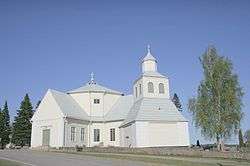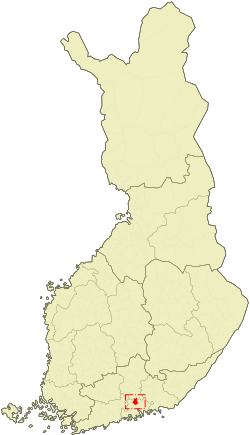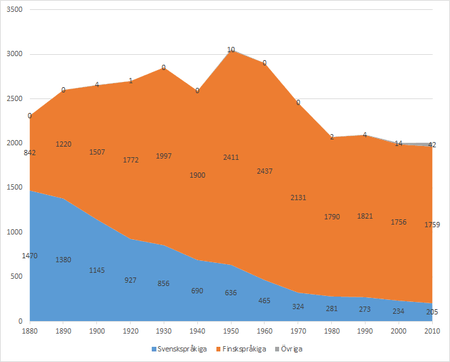Myrskylä
Myrskylä (Finnish pronunciation: [ˈmyrskylæ]; Swedish: Mörskom) is a municipality of Finland. It is located in the Uusimaa region. The municipality has a population of 1,925 (31 January 2019)[2] and covers an area of 206.35 square kilometres (79.67 sq mi) of which 5.98 km2 (2.31 sq mi) is water.[1] The population density is 9.61 inhabitants per square kilometre (24.9/sq mi). Neighbouring municipalities are Askola, Porvoo, Pukkila, Orimattila, Lapinjärvi and Loviisa.
Myrskylä Myrskylä – Mörskom | |
|---|---|
Municipality | |
| Myrskylän kunta Mörskoms kommun | |
 Myrskylä Church | |
 Coat of arms | |
 Location of Myrskylä in Finland | |
| Coordinates: 60°40′N 025°51′E | |
| Country | |
| Region | Uusimaa |
| Sub-region | Porvoo sub-region |
| Charter | 1636 |
| Seat | Myrskylä (Kirkonkylä) |
| Government | |
| • Municipality manager | Sam Vuorinen |
| Area (2018-01-01)[1] | |
| • Total | 206.35 km2 (79.67 sq mi) |
| • Land | 200.36 km2 (77.36 sq mi) |
| • Water | 5.98 km2 (2.31 sq mi) |
| Area rank | 262nd largest in Finland |
| Population (2019-01-31)[2] | |
| • Total | 1,925 |
| • Rank | 273rd largest in Finland |
| • Density | 9.61/km2 (24.9/sq mi) |
| Population by native language | |
| • Finnish | 87.2% (official) |
| • Swedish | 10.8% |
| • Others | 2% |
| Population by age | |
| • 0 to 14 | 17.4% |
| • 15 to 64 | 61.6% |
| • 65 or older | 21% |
| Time zone | UTC+02:00 (EET) |
| • Summer (DST) | UTC+03:00 (EEST) |
| Municipal tax rate[5] | 20% |
| Urbanisation | 44.6% |
| Unemployment rate | 11.0% |
| Climate | Dfb |
| Website | www.myrskyla.fi |
The Myrskylä parish was founded in 1636 when it was separated from Pernå by Isaacus Rothovius, the Bishop of Turku, and confirmed by Christina, the Queen of Sweden.
The falling pine tree in the municipality's coat of arms implicitly refers to the Finnish name of the municipality, Myrskylä (word "myrsky" means storm and "kylä" means village). Myrskylä's Swedish name Mörskom is believed to be an abbreviation for "Mörka skogarnas område", which literally means "the area of dark forests".
Geography
There are many lakes connected to the Myrskylänjoki watershed. These lakes are Pöyrysjärvi, Isojärvi, Vähäjärvi, Muttilanjärvi, Siippo, Sopajärvi, Kirkkojärvi and Sulkavanjärvi.
Population

In orange: Number of Finnish speakers.
In blue: Number Swedish speakers.
In grey: Number of people with another native language.
| Vuosi | Asukasluku |
|---|---|
| 1980 | 2 073 |
| 1981 | 2 047 |
| 1982 | 2 005 |
| 1983 | 1 994 |
| 1984 | 2 026 |
| 1985 | 1 998 |
| 1986 | 1 985 |
| 1987 | 1 979 |
| 1988 | 2 014 |
| 1989 | 2 051 |
| 1990 | 2 098 |
| 1991 | 2 066 |
| 1992 | 2 065 |
| 1993 | 2 054 |
| 1994 | 2 051 |
| 1995 | 2 040 |
| 1996 | 2 021 |
| 1997 | 2 011 |
| 1998 | 2 022 |
| 1999 | 2 036 |
| 2000 | 2 044 |
| 2001 | 1 974 |
| 2002 | 1 992 |
| 2003 | 2 012 |
| 2004 | 2 036 |
| 2005 | 2 033 |
| 2006 | 2 050 |
| 2007 | 2 026 |
| 2008 | 2 010 |
| 2009 | 2 021 |
| 2010 | 2 006 |
| 2011 | 2 008 |
The municipality is bilingual, with majority being Finnish and minority Swedish speakers.
Myrskylä is the birthplace of former Olympic track champion Lasse Virén. The educational department takes part in Lifelong Learning Programme 2007–2013 in Finland.
Politics
Results of the 2011 Finnish parliamentary election in Myrskylä:
- True Finns 27.1%
- Centre Party 22.0%
- National Coalition Party 15.7%
- Social Democratic Party 12.6%
- Swedish People's Party 10.0%
- Green League 4.6%
- Christian Democrats 3.7%
- Left Alliance 2.8%
References
- "Area of Finnish Municipalities 1.1.2018" (PDF). National Land Survey of Finland. Retrieved 30 January 2018.
- "Suomen virallinen tilasto (SVT): Väestön ennakkotilasto [verkkojulkaisu]. Tammikuu 2019" (in Finnish). Statistics Finland. Retrieved 15 March 2019.
- "Population according to language and the number of foreigners and land area km2 by area as of 31 December 2008". Statistics Finland's PX-Web databases. Statistics Finland. Retrieved 29 March 2009.
- "Population according to age and gender by area as of 31 December 2008". Statistics Finland's PX-Web databases. Statistics Finland. Retrieved 28 April 2009.
- "List of municipal and parish tax rates in 2011". Tax Administration of Finland. 29 November 2010. Retrieved 13 March 2011.
External links
![]()
- Municipality of Myrskylä – Official website, Finnish, Swedish
